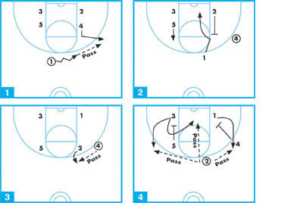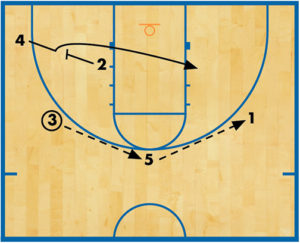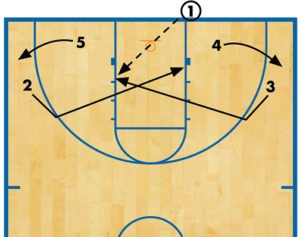‘Up’ entry into high-low motion offers early scoring chances
Our team runs a three-out, two-in high-low motion offense as our base offense. Our most successful entry has been the “Up” entry. There are several fundamental moves that make this entry successful.
Your options
UCLA cut. This cut has been a great scoring tool for us, whether it be on the flare cut for a 3-pointer from the top or on the hard basket cut. If you have a large point guard who is a strong player, you’ll occasionally get isolation in the post against a smaller defender.
 Ball screen. During an on-the-ball screen, you’ll have two excellent options to get a good scoring look.
Ball screen. During an on-the-ball screen, you’ll have two excellent options to get a good scoring look.
- Pick-and-roll option. Your post players set the ball screen and have a clear half court to work on the roll. You should drill this maneuver daily so the post can work on catching the pass on the roll. They also can learn when to shoot and when to put the ball on the floor, depending on their placement on the court and the help-side defenders.
- Dribble penetration. If the defenders switch on the ball screen, you can teach either 2 or 3 to take the bigger defender to the hole and try and get a shot or draw another defender and dish to a teammate who’s flashing to an open spot. If the defense uses a quick hedge move to shut down the pick-and-roll, instruct players to explode off the screen with the defender on his or her hip and head straight toward the basket. If the defender goes under the screen, your player will be left open for the 3-pointer.
Staggered screen. On this option, 4 and 3 set staggered screens for the point guard. If executed correctly, this is the screen that leads to the majority of your team’s shots. We almost always get either the point curling or catching inside of 15 feet for a jumper from the lane, or the flare screen for a jumper on the baseline (if the defender goes under the screens to shut down the curl).
Cross screen. You’ll also get shots for either 3 or 2 (whoever just set the staggered screen). Many times, that player’s defender helps on the staggered screen, breaks off the screen from 5, and is open either on a fade cut or another curl.
Note that each of these options comes within the first two passes of this set. If none of these options yield a shot, you can easily go into your high-low motion offense.

DIAGRAM 1: 2 and 3 either cross or make a V-cut to get open on the wings. 1 passes to either 2 or 3 and makes a UCLA cut off 4 or 5. 1 quickly posts up on the block for a one-count. 4 or 5 also take a one-count before going to set the ball screen.
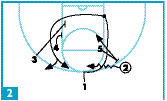
DIAGRAM 2: 5 sets the ball screen for 2, who looks for the pick-and-roll with 5. At the same time, 1 runs off of a double-screen from 3 and 4. 2 looks for 5 on the roll, or drives for either a shot or inside pass. He can also hit 1 coming off the curl screen.
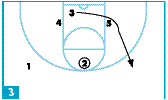
DIAGRAM 3: As 5 is on the block, he or she sets a pick for 3, who curls and looks for a shot. If 1 does not receive the pass on the curl, he or she fades out behind the 3-point line. If 3 doesn’t receive the pass off the curl or flare cut, he fans to the 3-point line and the pass goes to either 1 or 3 to start your motion offense.

